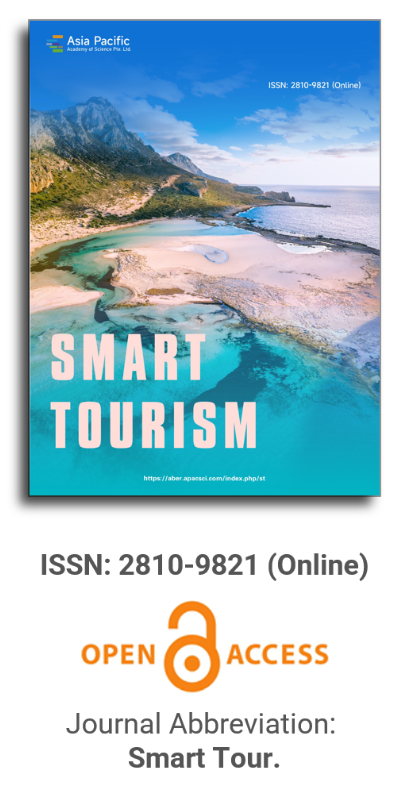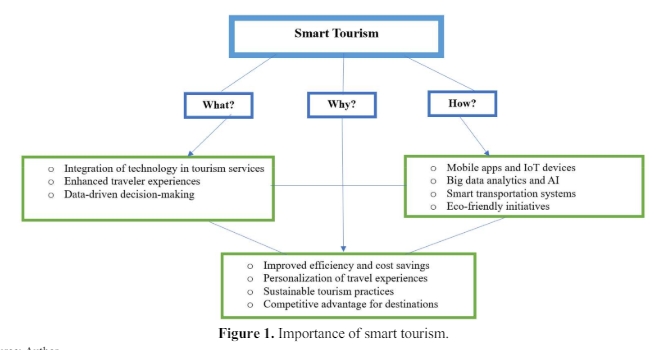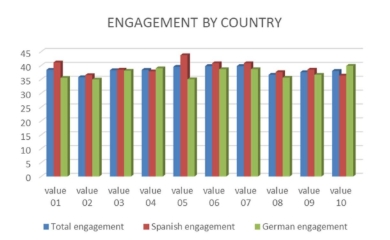


Tourism, industrialization, and sustainable economic growth
Vol 5, Issue 2, 2024
Download PDF
Abstract
The coordination between tourism and other industries contributes to the tourism sustainability as well as the sustainable economic growth. This study comprehensively examines the effect of the relationship between tourism development and industrialization on sustainable economic growth based on provincial data of China. By using the coupling coordination degree model and instrumental variable regression method, we found the following: (1) Tourism-industrialization coordination exerts positive and significant effects on sustainable economic growth. Additional robustness checks show that the results are reliable. (2) Economic development, tourism development, and manufacturing innovation moderate the effect of tourism-industrialization coordination on sustainable economic growth. (3) The sustainable economic growth effect of tourism is nonlinear and affected by tourism-industrialization coordination, and industrialization is important for tourism-led sustainable growth. The findings broaden the understanding of the relationship between tourism and economic sustainability from the perspective of industrial coordination. It may contribute to building a sustainable economic development path in developing countries.
Keywords
References
- UN. Sustainable development goals 17 goals to transform our world. Available online: http://www.un.org/sustainabledevelopment/sustainable-development-goals/ (accessed on 15 May 2024).
- Boluk KA, Cavaliere CT, Higgins-Desbiolles F. A critical framework for interrogating the United Nations Sustainable Development Goals 2030 Agenda in tourism. Journal of Sustainable Tourism. 2019; 27(7): 847-864. doi: 10.1080/09669582.2019.1619748
- Brau R, Lanza A, Pigliaru F. How Fast are Small Tourism Countries Growing? Evidence from the Data for 1980–2003. Tourism Economics. 2007; 13(4): 603-613. doi: 10.5367/000000007782696104
- Po WC, Huang BN. Tourism development and economic growth–a nonlinear approach. Physica A: Statistical Mechanics and its Applications. 2008; 387(22): 5535-5542. doi: 10.1016/j.physa.2008.05.037
- Liu A, Wu DC. Tourism productivity and economic growth. Annals of Tourism Research. 2019; 76: 253-265. doi: 10.1016/j.annals.2019.04.005
- Song H, Wu DC. A Critique of Tourism-Led Economic Growth Studies. Journal of Travel Research. 2021; 61(4): 719-729. doi: 10.1177/00472875211018514
- Kuznets S. Economic Growth and Income Inequality. American Economic Review. 1955; 45: 1-28.
- Copeland BR. Tourism, Welfare and De-industrialization in a Small Open Economy. Economica. 1991; 58(232): 515. doi: 10.2307/2554696
- Zhang H, Yang Y. Prescribing for the tourism-induced Dutch disease: A DSGE analysis of subsidy policies. Tourism Economics. 2018; 25(6): 942-963. doi: 10.1177/1354816618813046
- Faber B, Gaubert C. Tourism and Economic Development: Evidence from Mexico’s Coastline. American Economic Review. 2019; 109(6): 2245-2293. doi: 10.1257/aer.20161434
- Khanal BR, Gan C, Becken S. Tourism Inter-Industry Linkages in the Lao PDR Economy: An Input—Output Analysis. Tourism Economics. 2014; 20(1): 171-194. doi: 10.5367/te.2013.0255
- Kronenberg K, Fuchs M. Aligning tourism’s socio-economic impact with the United Nations’ sustainable development goals. Tourism Management Perspectives. 2021; 39: 100831. doi: 10.1016/j.tmp.2021.100831
- Calero C, Turner LW. Regional economic development and tourism: A literature review to highlight future directions for regional tourism research. Tourism Economics. 2019; 26(1): 3-26. doi: 10.1177/1354816619881244
- Song C, Chen JM, Nijkamp P, et al. Outward FDI in China’s hotel industry: An inward FDI perspective. Journal of Hospitality and Tourism Management. 2022; 52: 228-240. doi: 10.1016/j.jhtm.2022.06.012
- Liu X. Structural changes and economic growth in China over the past 40 years of reform and opening-up. China Political Economy. 2020; 3(1): 19-38. doi: 10.1108/cpe-05-2020-0010
- del P. Pablo-Romero M, Molina JA. Tourism and economic growth: A review of empirical literature. Tourism Management Perspectives. 2013; 8: 28-41. doi: 10.1016/j.tmp.2013.05.006
- Balaguer J, Cantavella-Jordá M. Tourism as a long-run economic growth factor: the Spanish case. Applied Economics. 2002; 34(7): 877-884. doi: 10.1080/00036840110058923
- Inchausti-Sintes F. Tourism: Economic growth, employment and Dutch Disease. Annals of Tourism Research. 2015; 54: 172-189. doi: 10.1016/j.annals.2015.07.007
- Deng T, Ma M. Booming tourism industry and urban economic growth. Tourism Economics. 2015; 22(5): 1161-1168. doi: 10.5367/te.2015.0475
- Fayissa B, Nsiah C, Tadasse B. Impact of Tourism on Economic Growth and Development in Africa. Tourism Economics. 2008; 14(4): 807-818. doi: 10.5367/000000008786440229
- Croes R, Ridderstaat J, Bąk M, et al. Tourism specialization, economic growth, human development and transition economies: The case of Poland. Tourism Management. 2021; 82: 104181. doi: 10.1016/j.tourman.2020.104181
- Ghalia T, Fidrmuc J. The Curse of Tourism? Journal of Hospitality & Tourism Research. 2015; 42(6): 979-996. doi: 10.1177/1096348015619414
- Terzioglu M, Gokovali U. Economic linkages and leakages in the hotel industry. Tourism Economics. 2016; 22(4): 715-728. doi: 10.1177/1354816616654244
- Nowak JJ, Sahli M. Coastal Tourism and ‘Dutch Disease’ in a Small Island Economy. Tourism Economics. 2007; 13(1): 49-65. doi: 10.5367/000000007779784452
- Waheed R, Sarwar S, Dignah A. The role of non-oil exports, tourism and renewable energy to achieve sustainable economic growth: What we learn from the experience of Saudi Arabia. Structure Change and Economic Dynamics. 2020; 55: 49-58. doi: 10.1016/j.strueco.2020.06.005
- Jiao X, Li G, Qiu RTR, et al. Analyzing Destination Resilience from A Spatiotemporal Perspective. Journal of Travel Research. 2024. doi: 10.1177/00472875241245048
- Szromek AR, Herman K, Naramski M. Sustainable development of industrial heritage tourism – A case study of the Industrial Monuments Route in Poland. Tourism Management. 2021; 83: 104252. doi: 10.1016/j.tourman.2020.104252
- Li S, Liu A, Song H. Does tourism support supply-side structural reform in China? Tourism Management. 2019; 71: 305-314. doi: 10.1016/j.tourman.2018.10.022
- Dong E, Wang Y, Morais D, et al. Segmenting the rural tourism market. Journal of Vacation Marketing. 2013; 19(2): 181-193. doi: 10.1177/1356766712471231
- Narayan PK, Narayan S, Prasad A, et al. Tourism and Economic Growth: A Panel Data Analysis for Pacific Island Countries. Tourism Economics. 2010; 16(1): 169-183. doi: 10.5367/000000010790872006
- Qian J, Feng D, Zhu H. Tourism-driven urbanization in China’s small town development: A case study of Zhapo Town, 1986–2003. Habitat International. 2012; 36(1): 152-160. doi: 10.1016/j.habitatint.2011.06.012
- Nowak J, Sahli M, Sgro PM. Tourism, trade and domestic welfare. Pacific Economic Review. 2003; 8(3): 245-258. doi: 10.1111/j.1468-0106.2003.00225.x
- Chao CC, Hazari BR, Laffargue JP, et al. Tourism, dutch disease and welfare in an open dynamic economy. The Japanese Economic Review. 2006; 57(4): 501-515. doi: 10.1111/j.1468-5876.2006.00400.x
- Pham TD. Tourism Productivity Theory and Measurement for Policy Implications: The Case of Australia. Journal of Travel Research. 2019; 59(2): 247-266. doi: 10.1177/0047287519835972
- Ehigiamusoe KU. Tourism, growth and environment: analysis of non-linear and moderating effects. Journal of Sustainable Tourism. 2020; 28(8): 1174-1192. doi: 10.1080/09669582.2020.1729164
- Capó J, Font AR, Nadal JR. Dutch Disease in Tourism Economies: Evidence from the Balearics and the Canary Islands. Journal of Sustainable Tourism. 2007; 15(6): 615-627. doi: 10.2167/jost698.0
- Kožić I. Can tourism development induce deterioration of human capital? Annals of Tourism Research. 2019; 77: 168-170. doi: 10.1016/j.annals.2018.12.018
- Li T, Li Y, An D, et al. Mining of the association rules between industrialization level and air quality to inform high-quality development in China. Journal of Environmental Management. 2019; 246: 564-574. doi: 10.1016/j.jenvman.2019.06.022
- Tang Z. An integrated approach to evaluating the coupling coordination between tourism and the environment. Tourism Management. 2015; 46: 11-19. doi: 10.1016/j.tourman.2014.06.001
- Li P. The outlook for China’s innovation-driven development beyond COVID-19. Cultures of Science. 2020; 3(4): 232-244. doi: 10.1177/2096608321995294
- Assaker G, Hallak R, Vinzi VE, et al. An Empirical Operationalization of Countries’ Destination Competitiveness Using Partial Least Squares Modeling. Journal of Travel Research. 2013; 53(1): 26-43. doi: 10.1177/0047287513481275
- Zhang H, Gu CL, Gu LW, et al. The evaluation of tourism destination competitiveness by TOPSIS & information entropy —A case in the Yangtze River Delta of China. Tourism Management. 2011; 32(2): 443-451. doi: 10.1016/j.tourman.2010.02.007
- Zeng DZ, Zhu X. Tourism and industrial agglomeration. Japanese Economic Review. 2010; 62(4): 537-561. doi: 10.1111/j.1468-5876.2010.00518.x
- Smeral E. A Structural View of Tourism Growth. Tourism Economics. 2003; 9(1): 77-93. doi: 10.5367/000000003101298286
- Yu B. Urban spatial structure and total-factor energy efficiency in Chinese provinces. Ecological Indicators. 2021; 126: 107662. doi: 10.1016/j.ecolind.2021.107662
- Liu Z, Xin L. Has China’s Belt and Road Initiative promoted its green total factor productivity?—Evidence from primary provinces along the route. Energy Policy. 2019; 129: 360-369. doi: 10.1016/j.enpol.2019.02.045
- Yuan H, Feng Y, Lee CC, et al. How does manufacturing agglomeration affect green economic efficiency? Energy Economics. 2020; 92: 104944. doi: 10.1016/j.eneco.2020.104944
- Aratuo DN, Etienne XL. Industry level analysis of tourism-economic growth in the United States. Tourism Management. 2019; 70: 333-340. doi: 10.1016/j.tourman.2018.09.004
- Tu J, Zhang D. Does tourism promote economic growth in Chinese ethnic minority areas? A nonlinear perspective. Journal of Destination Marketing & Management. 2020; 18: 100473. doi: 10.1016/j.jdmm.2020.100473
- Ju J, Lin JY, Wang Y. Endowment structures, industrial dynamics, and economic growth. Journal of Monetary Economics. 2015; 76: 244-263. doi: 10.1016/j.jmoneco.2015.09.006
- Benczúr P, Karagiannis S, Kvedaras V. Finance and economic growth: Financing structure and non-linear impact. Journal of Macroeconomics. 2019; 62: 103048. doi: 10.1016/j.jmacro.2018.08.001
- Gyedu S, Heng T, Ntarmah AH, et al. The impact of innovation on economic growth among G7 and BRICS countries: A GMM style panel vector autoregressive approach. Technological Forecasting and Social Change. 2021; 173: 121169. doi: 10.1016/j.techfore.2021.121169
- Arvin MB, Pradhan RP, Nair MS. Are there links between institutional quality, government expenditure, tax revenue and economic growth? Evidence from low-income and lower middle-income countries. Economic Analysis and Policy. 2021; 70: 468-489. doi: 10.1016/j.eap.2021.03.011
- Lv Z. Deepening or lessening? The effects of tourism on regional inequality. Tourism Management. 2019; 72: 23-26. doi: 10.1016/j.tourman.2018.11.009
- Pulido-Fernández JI, Cárdenas-García PJ. Analyzing the Bidirectional Relationship between Tourism Growth and Economic Development. Journal of Travel Research. 2020; 60(3): 583-602. doi: 10.1177/0047287520922316
- Li KX, Jin M, Shi W. Tourism as an important impetus to promoting economic growth: A critical review. Tourism Management Perspectives. 2018; 26: 135-142. doi: 10.1016/j.tmp.2017.10.002
- Ellison G, Glaeser EL, Kerr WR. What Causes Industry Agglomeration? Evidence from Coagglomeration Patterns. American Economic Review. 2010; 100(3): 1195-1213. doi: 10.1257/aer.100.3.1195
- Morley CL. Dynamics in the Specification of Tourism Demand Models. Tourism Economics. 2009; 15(1): 23-39. doi: 10.5367/000000009787536654
- Hayashi F. Econometrics. Princeton: Princeton University Press; 2000.
- Liu J, Nijkamp P, Lin D. Urban-rural imbalance and Tourism-Led Growth in China. Annals of Tourism Research. 2017; 64: 24-36. doi: 10.1016/j.annals.2017.02.005
- Li H, Chen JL, Li G, et al. Tourism and regional income inequality: Evidence from China. Annals of Tourism Research. 2016; 58: 81-99. doi: 10.1016/j.annals.2016.02.001
- Hansen B. Threshold effects in non-dynamic panels: Estimation, testing, and inference. Journal of Economics. 1999; 93(2): 345-368. doi: 10.1016/S0304-4076(99)00025-1
- Zuo B, Huang S. Revisiting the Tourism-Led Economic Growth Hypothesis: The Case of China. Journal of Travel Research. 2017; 57(2): 151-163. doi: 10.1177/0047287516686725
- Santamaria D, Filis G. Tourism demand and economic growth in Spain: New insights based on the yield curve. Tourism Management. 2019; 75: 447-459. doi: 10.1016/j.tourman.2019.06.008
- Fahimi A, Akadiri SS, Seraj M, et al. Testing the role of tourism and human capital development in economic growth. A panel causality study of micro states. Tourism Management Perspectives. 2018; 28: 62-70. doi: 10.1016/j.tmp.2018.08.004
Supporting Agencies
Copyright (c) 2024 Changyao Song, Qi Zhang, Jingjing Yang , Xinjian Li
License URL: https://creativecommons.org/licenses/by/4.0/

This site is licensed under a Creative Commons Attribution 4.0 International License (CC BY 4.0).

Prof. Hung-Che Wu
Nanfang College, Guangzhou
China
Indexing & Archiving
Asia Pacific Academy of Science Pte. Ltd. (APACSCI) specializes in international journal publishing. APACSCI adopts the open access publishing model and provides an important communication bridge for academic groups whose interest fields include engineering, technology, medicine, computer, mathematics, agriculture and forestry, and environment.



.jpg)
.jpg)

.jpg)

